Folio 1
The Proof Sheet and the Portfolio
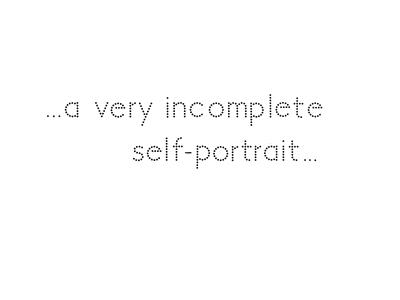
A Very Incomplete Self-Portrait, Title sheet. 1971. Hand designed by the artist on archival mounting board.
Tom Dorsey: Afterwards, I would go through my proof sheet, and I would mark what I wanted and decide what's going to be next to what, and then I might shift them at a point. But I put 'em all together. Once I'd made the decision, then I went in my darkroom and printed them all and then mounted them. This, like I said, within a month, the whole process was finished from thinking it, developing it, processing it, and mounting it and putting it together. This was all nice and neat back in the day. See, this plastic didn't exist. I had to do that later over the years because this was disintegrating. But, uh, they were really nice and neat back when I did it.
Folio 3
"...how I saw myself"
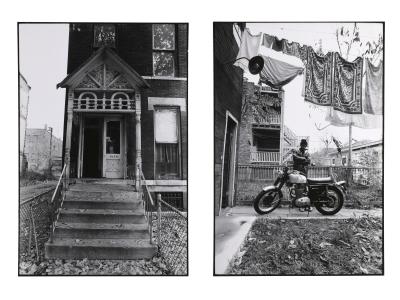
A Very Incomplete Self-Portrait, Folio 3. 1971. Gelatin silver prints.
Tom Dorsey: [This is] part of how I saw myself, that's what this is about. This is a self-portrait, and that's why I call it a very incomplete version of that. This was important to me, um, this place where I lived and it got to the point where my sinuses would not allow me to ride my, my bikes around the corner, around the block one time—I wouldn't be able to sleep that night. It was that bad. But that was God preparing me to come here [Atlanta].
This is standard, back in the day, too, for drying your clothes. We didn't—we didn't have a washer and dryer. Matter of fact, when we moved here, we didn't have a dryer. We had the old-fashioned washing machine, and we would hang 'em out in Adams Park. We didn't make it up. There was a clothes line on the back lot behind us. And our kids, they got hooked into what Atlanta was about and that embarrassed them: “Mom. Dad. Don't hang it.” So eventually to make them happy, we quit hanging them back there.
Folio 5
"I was the oldest boy..."
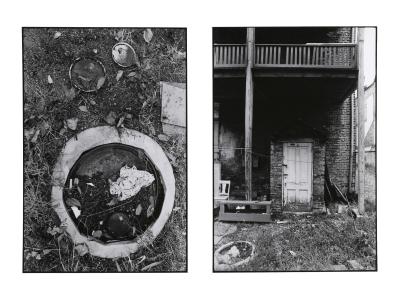
A Very Incomplete Self-Portrait, Folio 5. 1971. Gelatin silver prints.
Tom Dorsey: That was part of what my [pauses] I related to what part of what my father did. He couldn't afford to have people to come in and rod the sewer when it would back up. So, he would hold me by my ankles upside down and I would be down in there, rodding it out. That was my job. That's what I remember. Because I was the oldest boy, I was always the one that was told to do all the stuff that you see me doing.
See, this is years later when my mom was considering selling it because she couldn't maintain it anymore. And you gotta remember, this is how old I was [points to self-portrait with motorcycle]. I, I wasn't living there anymore. See, this is where I'm living. And see I'm married with two children.
Folio 6
“The view from the back porch...”
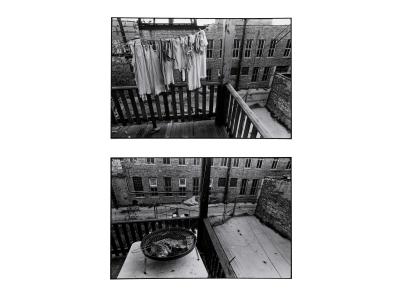
A Very Incomplete Self-Portrait, Folio 6. 1971. Gelatin silver prints.
Tom Dorsey: [This is] the stuff that you saw on the back porch. But it also shows the environment. See what you see back there on the other side of that alley is typical for Fulton Street. Those are the main, typical buildings. If you were to go up and down the alley behind Fulton Street, that would be standard. You see a home or two here, and then you see a business.
The third floor [top photograph]. And that's the second floor [bottom photograph]. That's the details on that shot. That's all that brings you up close. To see closer what's in the bigger picture. And that's why you see me doing details because um, that's the only way that I could remember and relate to certain things.
You'd be surprised at the stuff that people would be doing on the back porch, but not lounging, which is standard now. There was no lounging in those days. Everything was serious. Yeah.
The purpose really is to answer questions—questions you might have. If you don't have it, then you just flip to the other one. But if you do, that's a detail to give you an embellishment of what I was experiencing and how I felt about it. Otherwise, I wouldn't have photographed it if it didn't blend into what I remembered.
Folio 9
All Black and White
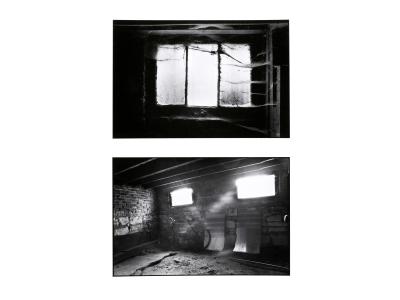
A Very Incomplete Self-Portrait, Folio 9. 1971. Gelatin silver prints.
Tom Dorsey: Well, the fact that they're in black and white versus color—because I was a color freak! This gives you an idea of what I would normally do [points to color photograph, not shown here]. But for this project I decided to go black and white because this [color] puts too much spirit in it. And uh, I didn't want that. I wanted it to be blank. I wanted it to be feeling less. I wanted it to be like I described, that cold—whatever words I used—environment, I felt it. Um, and later on I needed to re-feel that to get a sense of... ‘cause a lot of things that I was experiencing at that time, I forgot. But when I look back at these photographs, it brings that stuff back to me.
Folio 10 & Folio 11
Lighting and Printing
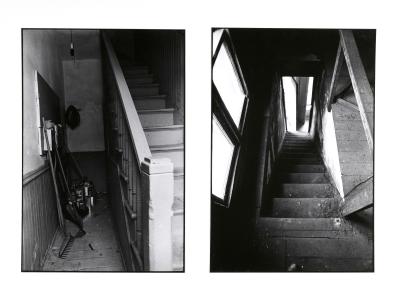
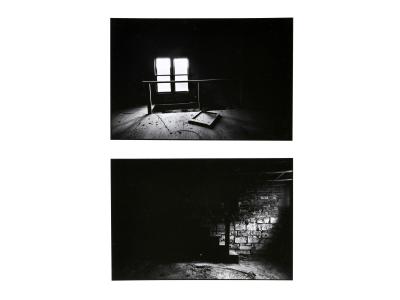
A Very Incomplete Self-Portrait, Folio 10 & Folio 11. 1971. Gelatin silver prints.
Tom Dorsey: Just get a general reading here at the light meter. And it lets you know the general amount of illumination in here, and then you expose accordingly. Now when you get ready to print, you decide how deep you're gonna go to get the details or how light you're gonna print it, um, so that you can see stuff in the shadow. And, um, for normal printing—other than this—you can combine the two in the same print and they call it burning, you know? Or dodging. You're holding back in some areas. And you're putting more time on others. Technique, basic stuff.
And I select the image cause it's saying something that I want to have said and then I print it until... 'cause a lot of times this was not the only print made. I would print to a point to, to give me the information that I'm sensitive to and um, I might have to do it over again 'cause I don't have enough information, so I print it deeper. And then finally when I'm satisfied that becomes a print that is actually used, the rest is thrown away.
Folios 13-15
Mapping the Project Housing
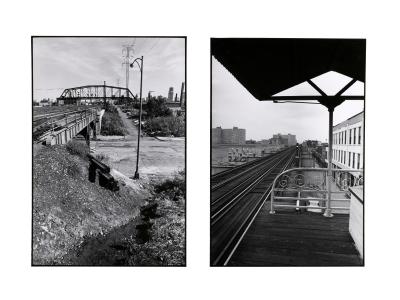
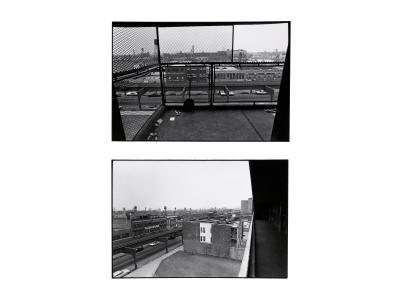
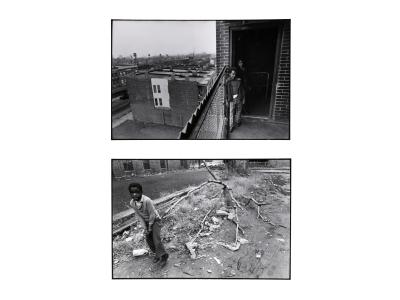
A Very Incomplete Self-Portrait, Folios 13-15. 1971. Gelatin silver prints.
Tom Dorsey: Here is the housing project. This is Lake Street. This is where you remember the, the, the TV series. What was the name of it? It had this goofy kid always making faces and doing stupid stuff.
Andi McKenzie: Good Times?
Tom Dorsey: That's it. That's where, that's where that was supposed to occur. See, none of that exists now. This is maybe a block east of where I lived, and watch this, Fulton Street, it was two blocks over, running the same direction. Right. Because this goes downtown and that's that one on that end. Right. So that's west. And this is east? Mm-hmm, that's east. This is west. That's the relationship there. This is where we are.
Anna Clark: On top of the, the project buildings?
Tom Dorsey: Mm-hmm. See where we're, where we're photographing from is down the street. Everything relates, at least I tried to attach, you know, as busy and as many human beings as you—and all over the place here—I purposefully left humans out of it until I decided to include them. See, so it's isolated and it's cold. The people are gonna change, whereas these things are not going to change. That's the perception anyway. This is looking down.
Anna Clark: Oh, so you just turned the corner?
Tom Dorsey: Mm-hmm.... And then that's where they are. So, we come from upstairs in the development, back to the ground and see, if you'll notice anytime I show a human, the humans are gonna occupy both spaces together. I never do one where there's a human one, and then this is all cold and mechanical over here.
Folios 17-19
School Grounds
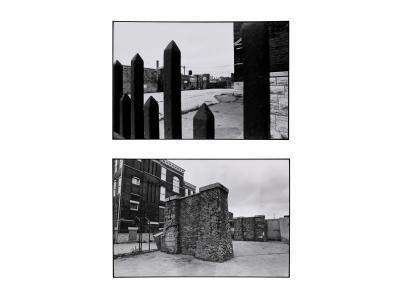
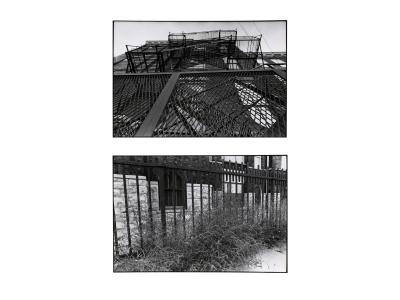
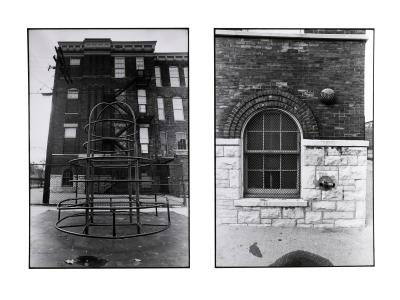
A Very Incomplete Self-Portrait, Folios 17-19. 1971. Gelatin silver prints.
Tom Dorsey: To me that that reminded me of, of a prison. Again, don't ask me why, but that's what I saw. And when I photographed this, it just showed that my positive feeling was not about this. That's, this is illustrating, um, my depression. I guess you would call it, but I never thought I was depressed. I was just not a happy person because I had nobody who understood what I was experiencing, even though I would always try to be a part of the group, part of what was going on, but nobody would extend it my way. I was always by myself doing stuff by myself. Okay. And then I would share what they're doing, with what, you know.... [pauses] And I remember several times we had to go down these fire escapes just for practice....
Folio 20
"This was my play area..."
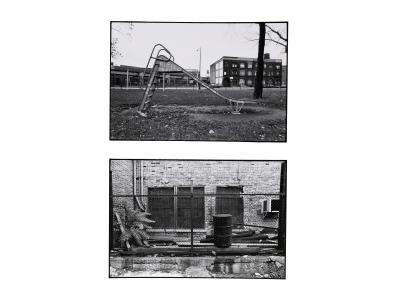
A Very Incomplete Self-Portrait, Folio 20. 1971. Gelatin silver prints.
Tom Dorsey: [I showed this] photograph to an old friend of mine who lived in an apartment building, one of those back there. And he saw that and he broke into tears, uh, ‘cause that's where he grew up. But right across the street from this park, that was the main park. Down at Ashland near where the "L" track photographs that I took up on the platform.
The platform is right here on this corner. But the purpose of this photograph was that this [the alley, bottom image] is coming off of this [the slide, top image] as a play situation. That's the purpose of a slide. Well, this is where I used to play. This is behind my house on Fulton Street. That's the alley. And uh, that was normal for me. But back when I was a kid growing up, they didn't have these wire fences separating the way that it is now, but whatever their refuse was that they would throw out, the garbage people would come up the alleys and pick up that stuff. That's the area. Well, if the fence is there, they can't get it. But growing up that didn't exist. And it goes on again that this is a play area. This is my play area. That was a general play area. It...that's my play area.
Folio 24
Gas Stations
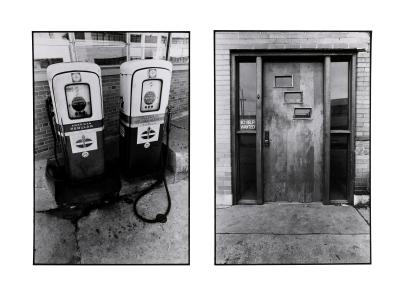
A Very Incomplete Self-Portrait, Folio 24. 1971. Gelatin silver prints.
Tom Dorsey: ...one of my buddies who grew up on the street that I was on. And this is one block, the next block up, this is Fulton Street. Down Fulton Street. The street here is Fulton Street, but they're, uh, two blocks apart. And this, my buddy, he ended up owning this old gas station up on the West End, and this was Scheffler’s end, where he started with his original gas pumps. And the difference is that this was, in a sense, a multimillion-dollar business at this point. And this guy, at the same time, he, he was barely making ends meet.
Folio 30
Theaters
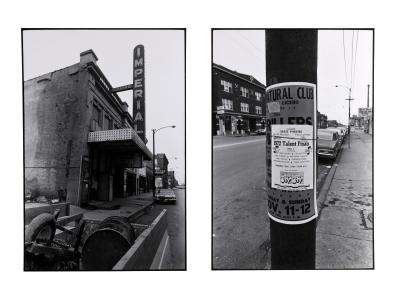
A Very Incomplete Self-Portrait, Folio 30. 1971. Gelatin silver prints.
Tom Dorsey: And this is up Madison Street, this is that, um, in that same block. Mm-hmm, uh, that was Imperial. That was our top theater back at that time as a kid. And the only time I ever went into that theater was with my parents when they would afford to take us in there to see some big movie or something. Uh, further up, closer to where we lived, um, there was another theater that most of the kids would go to and, uh, it would cost us 25 cents or less. Whatever it was, it was almost nothing. And we would save our little pennies and do what we can to go see. And the main attraction—as quiet as it was kept—were cartoons. They would show at 12 o'clock, you want to get there before 12 o'clock if you're gonna go that day and you would see maybe about ten cartoons. And that's the only time they would show ten cartoons.
Anna Clark: That's a lot of cartoons in a row!
Tom Dorsey: Oh yeah, man. And people would be into them cartoons and Mickey Mouse and Donald Duck and Bugs Bunny and all the crazies that we were used to. And then you would see the features and the features in that theater, seeing that this is the low end, was primarily Westerns. And so we became Western freaks. All, all of my buddies and I, everybody wanted to be a cowboy – as crazy as that sounds—because you wanted to ride the horse and twirl, and you got your little pistols and...
Folio 35
"This is Frank's"
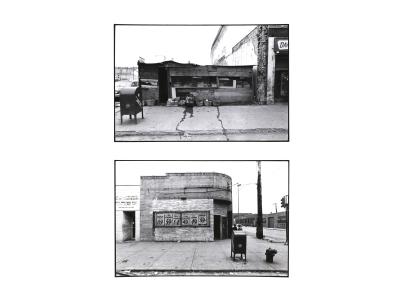
A Very Incomplete Self-Portrait, Folio 35 (located in center case). 1971. Gelatin silver prints.
Tom Dorsey: This, going up this street, is to Fulton Street, where I lived in the same block on Fulton. This is two blocks over. This is Frank's [bottom photograph]. I never will forget Frank's. This is where we bought our groceries. All of our food always came from Frank's because Frank allowed my parents to have credit, you know, and they would pay once a week, whatever credit they've accumulated for that week.
But back when I was a kid, they didn't have nice signs like this on Frank’s store. A Jewish owner; this was a Black owner [top photograph]. They had nice—you could walk inside. They had a butcher, a counter with a, a butcher behind the counter so you can look in there and order what you want in the glass. This is high, high class in—in the sense of our neighborhood.
This was more standard [top photograph]. You didn't go inside for anything. Everything you bought, you would buy from the sidewalk here. You would look and see it and there would be a guy behind there and he would, you know, direct you and sell to you. You go from Fulton on North for a couple of blocks, and that separated the poor West Side from the quote middle-ish North onto solid middle [class] as you go north.
And now we used to have to walk here to get the groceries. My mother would always write a list of what she wanted and my job was to go and pick it up and bring it back. ‘Cause I'm the oldest one, so I'm responsible for everything else. And um, this one street between Lake Street and Fulton Street—up here lived the guy who used to bully me. And it got to the point where he could see me walking from my house to Frank's, and he would be waiting for me when I’d come back with my groceries. And he would come and go through my pockets while I'm hauling my bags to see if there's any change left and he would take it. It's the memories and the feelings that I had about that that caused me to want to document that and relate that in a funny way with this [top photograph] up here.
This is where a lot of people—this is all they had, but this is all we had and what you believe right across the street here is that housing project? A huge, like two blocks—
Anna Clark: from Frank’s?
Tom Dorsey: So all of that business would come here. He—he got, I won't say wealthy, but he made tons of money there, right? He was a nice guy. Nobody ever said anything negative about Frank. I don't remember even his last name. Never knew his last name. I just knew that was Frank. That was Mr. Frank. And that's what I called him. And all of the people that he hired—this is a strange thing—they were all from the community. They were Black. He was, he was supportive. And we're talking in the forties...
Folio 37 & Folio 39
McKinley High School
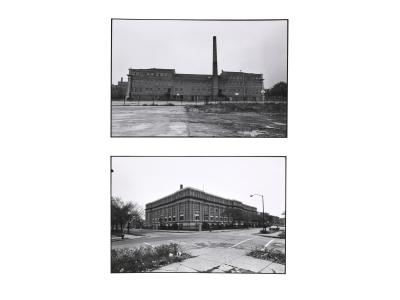
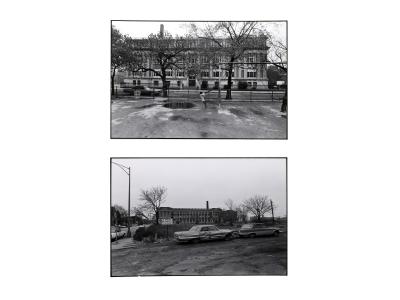
A Very Incomplete Self-Portrait, Folio 37 & Folio 39. 1971. Gelatin silver prints.
Tom Dorsey: That's a co-ed: McKinley. It looks so cold, but that's the reality. But looking back at my experience in that complex—with the students and the teachers, the environment—what I picked up is what I feel when I look at how I depicted them. That's one of the reasons, too, I decided not to do this in color because that would put life into it. That would put—you wouldn't feel the same way. It—it'll lift your spirits up, if it were in color.
[Right photograph, bottom image] These are, um, cars that have been thrown away in this parking lot, and I decided to go there to depict that, so we see what the environment is. This is Crane Tech. This is Jackson. Going down Jackson. See, that's the street I lived on—that relates to the school. Those are the kids. That's what it relates to. It's a dumping ground, even though you're not supposed to dump here in this school. This represents what should not be occurring in the school. That's why I did that shot that way.
Folio 42
"People represents ideas..."
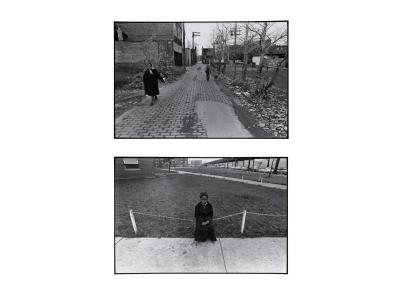
A Very Incomplete Self-Portrait, Folio 42. 1971. Gelatin silver prints.
Tom Dorsey: All of these non-human shots related to the human. They represented the story to me of the humans because it's all kind of stories when you look at the, the buildings. But when you look at the humans, um, you, you can't get into their private whatever. They were influenced by, and they influenced those environments.
The only time they were not in motion was the very last scene of the young lady sitting on the link. And she just looked as if she was asking the question about life, “what's going on? Why are things the way they are?” See, I'm really thinking myself, but that's [pauses] she had the look that expressed how I felt. So that's why I took it and used it.




